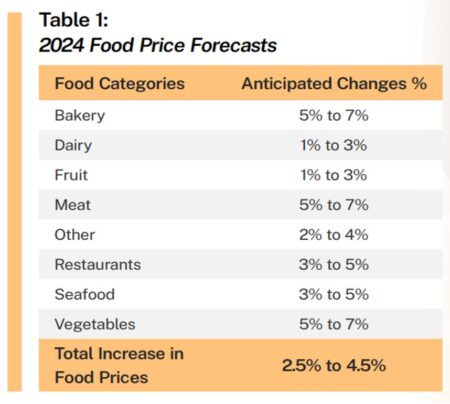Marginal Increase in Food Prices Predicted

The 2023 Canada Food Price Report is the 14th report that provides Canadians with insights on what to anticipate regarding changes to food prices in 2024. Reports over the past several years have all predicted significant price increases, above 5% in most instances. While the authors of the 2023 Canada Food Price Report are predicting an increase in prices for 2024, the increase is more modest than in past years, predicted to rise 2.5% – 4.5%. It is estimated that a family of four will spend $16,300 on groceries and food for the year, an increase of $700 over 2023.
One year ago, the 2022 report predicted price increases ranging from 5% – 7%. Consumer Price Index data to mid-October identifies an increase of 5.9%, helping to demonstrate the strength of the research that goes into preparing the Food Price Report.
Price Increases by Category
Bakery products are predicted to be at the top of the price increase spectrum for 2024. In part, the estimated increase of 5% – 7% is a result of the estimated 13% decline in wheat production across the prairie provinces. Significant portions of Alberta, Saskatchewan and Manitoba experienced lower than average precipitation, resulting in decreased yield. Meat is also predicted to rise by the similar 5% – 7% range. This increase may be due in part to lower beef herd numbers as farmers and ranchers have been forced to sell cattle in the prairies due to numerous years of below-average precipitation and droughts. The decline in the number of cattle resulted in lower volumes, which puts pressure on prices to rise. Vegetables are the third category to rise by 5% – 7%. This may be partially explained by the on-going labour challenges, whereby fewer acres of vegetable crops are being seeded and/or harvested. The Conference Board of Canada estimates that 40% of employers seeking to hire labour in agriculture haven’t been able to fill available positions.
Restaurant spending and seafood are estimated to rise by 3% – 5%. Restaurants are being impacted by labour shortages as well as both rising wages and ingredient costs. These factors impact meal prices, with some restaurants being open for fewer hours due to labour shortages. Restaurants Canada reports that one out of every three restaurants is losing money. Seafood production, however, has been impacted by lower catch quotas in recent years, resulting in less product being available, which contributes to higher prices.
Dairy and fruit are anticipated to be in the lower price increase categories at 1% – 3%. Dairy producers have opted to delay their anticipated price increase by three months in 2024, which contributes to keeping price increases to a minimum. A planned 1.77% increase in the price of milk will come into effect May 1, rather than February 1 as in previous years. Both the volume and value of fruit production in Canada has been increasing in recent years. Higher production volumes will contribute to generate price stability for fruit products in grocery stores.
Household Spending
The Food Price Report estimates that a household of four individuals, two parents and two teenagers, will spend just over $700 more on groceries and food in 2024, than in 2023. The increased money budgeted to feed a family will have to compete with rises in other household expenses. Canada Mortgage and Housing Corporation estimates that 45% of all Canadian mortgages will be renewed in 2024 and 2025. The rapid rise in interest rates will result in higher mortgage payments for many home owners, potentially negatively impacting the amount of disposable income available for food purchase.
Statistics Canada reporting on year-over-year consumer spending from August 2022 to August 2023, found consumers spent an average of $8.35 per person less on groceries. It is estimated that households spent $252.89 in August 2023 to feed each individual in the household. For a family of four, over the course of one year, this would amount to the household spending nearly $700 less on groceries and food.
Food Prices by Province
Portions of eastern Canada are predicted to experience slightly lower than average food price increases in 2024. The national average increase is estimated to be 2.55 – 4.5%, with Newfoundland, PEI and Quebec all expected to experience increases lower than this range. BC is predicted to fall within the estimated range, with all other provinces slightly above the average range. The lower than average range price increases will be very welcomed in the Maritimes and Quebec as they experienced the highest range of price increases for 2023. Last year, price increases ranging from 5% – 7% were predicted and these five provinces were the only ones to experience increases above 6%.
Good News or Bad?
Given all of the international and domestic factors influencing food production and distribution, a price increase of 2.5% – 4.5% can be viewed as positive. The ongoing war in Ukraine and Israel contribute to raising uncertainty in commodity markets. Water shortages in the USA, labour strikes in ports and retail stores and tax increases are among other factors that influence food prices on a regular basis. All these factors are having an increasing impact on food production and distribution, which could potentially have resulted in even higher price increases from what are presently estimated. While it isn’t necessarily ‘good news’, the fact that price increases are lower than what was anticipated, should be viewed as good news.
The newest edition of the Canada Food Price Report is available at:
https://www.dal.ca/sites/agri-food/research/canada-s-food-price-report-2024.html

